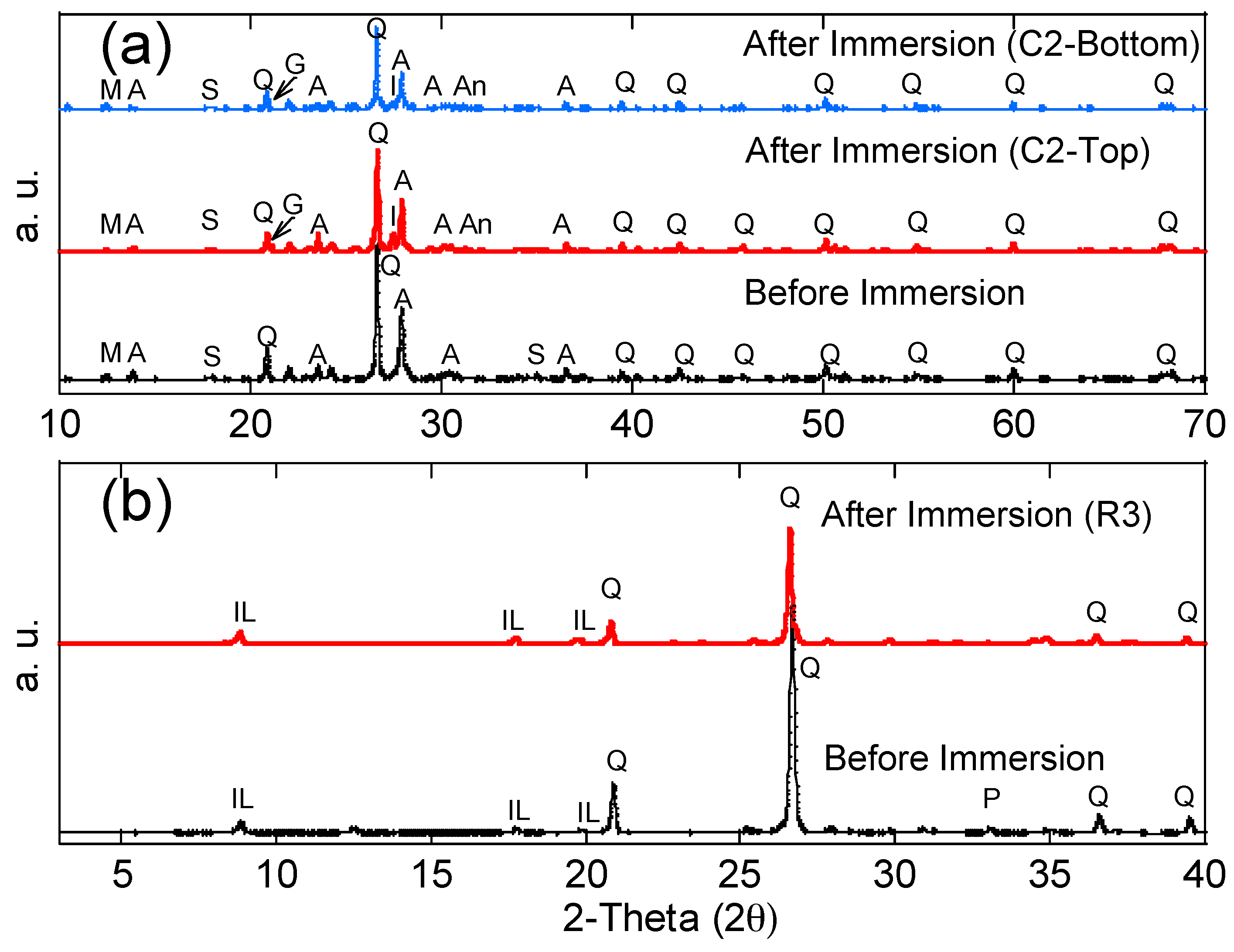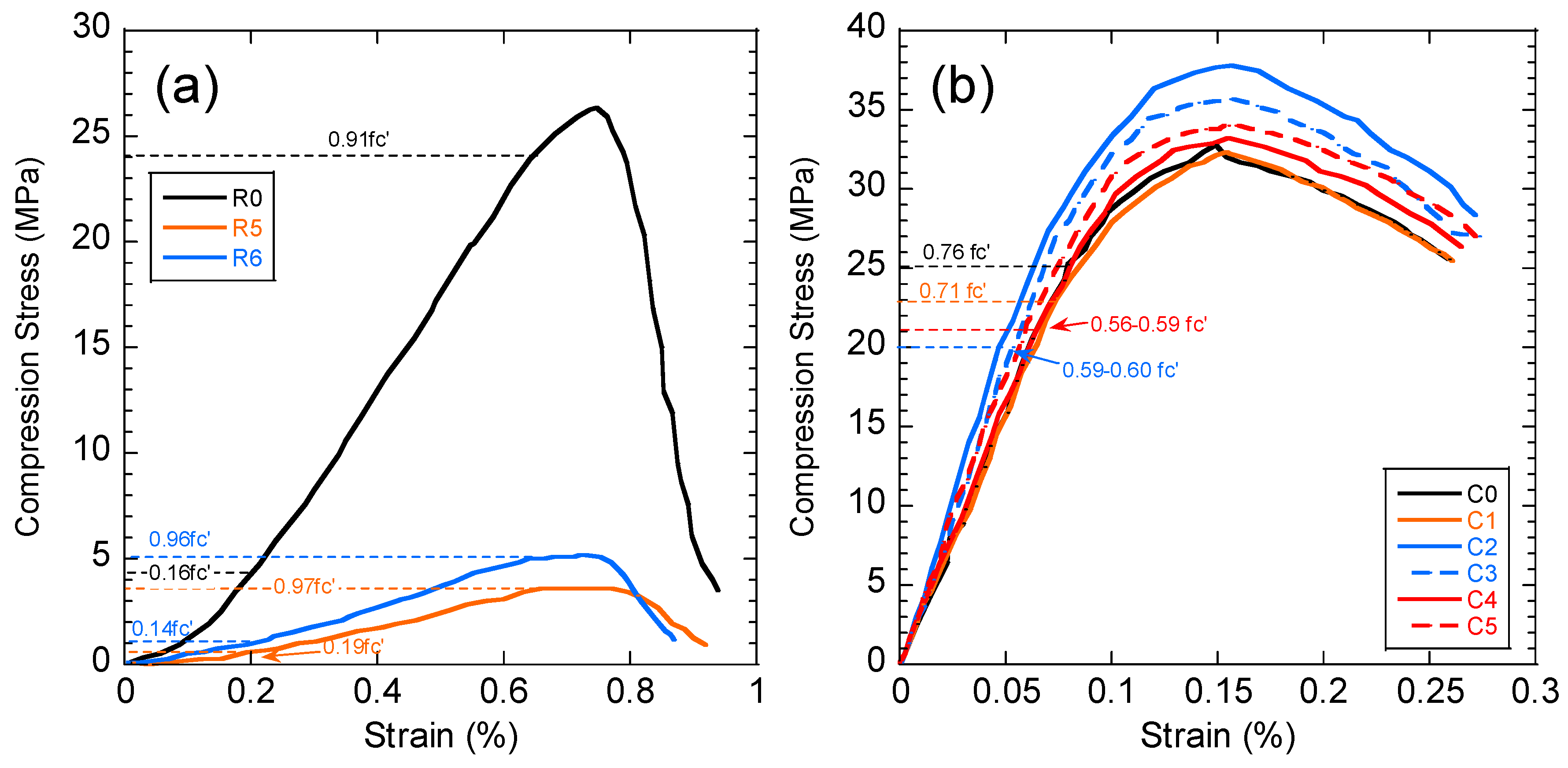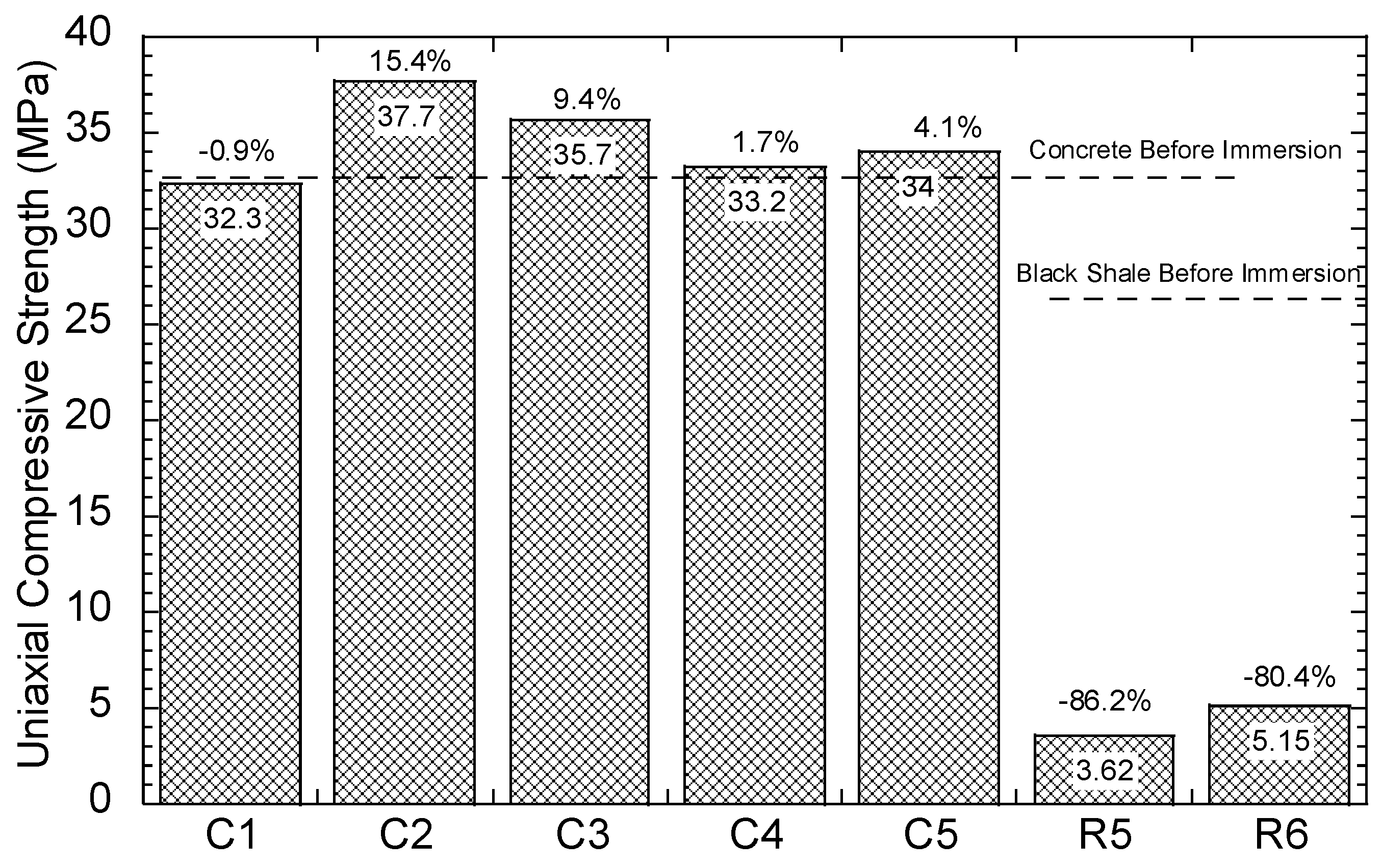Deterioration and Oxidation Characteristics of Black Shale under Immersion and Its Impact on the Strength of Concrete
Abstract
1. Introduction
2. Materials and Methods
2.1. Black Shale Samples
2.2. Laboratory Black Shale-Concrete Immersion Tests
2.3. Water Chemistry Analysis
2.4. Ultrasonic Speed Test
2.5. Uniaxial Compressive Strength (UCS) Test
3. Results and Discussions
3.1. Temporal Behavior of the Water Chemistry
3.1.1. pH of the Water of the Immersion Tests
3.1.2. Electrical Conductivity and Elemental Concentrations in Water
3.2. The Quality and Continuity of the Concrete before and after the Immersion Tests
3.3. Compressive Strength of the Concrete and Black Shale before and after the Immersion Tests
4. Conclusions
- Under the partially saturated condition, the oxidation of sulphide minerals in the black shale, i.e., pyrite in this study, depended on the immersion depth. Lower immersion depth of the black shale led to a higher degree of oxidation with lower pH, higher EC, and more abundant weathering products, such as SO42−, and Fe, in the immersion solution. This observation was likely due to the oxidation and mass transfer in the capillary zone in black shale. Additionally, the oxidation and dissolution of minerals reduced the compressive strength of black shale.
- The acid discharge from the black shale showed a negative impact on the quality and entirety of the concrete in the immersed zone, but presented a positive impact on the non-immersed zone. The ultrasonic velocity of the concrete decreased in the immersed zone, which was due to the dissolution-induced reduction of concrete quality and entirety. However, the ultrasonic velocity of the concrete increased in the non-immersed zone. This phenomenon attributes to the mineral precipitation and hydration that occurred in the non-immersed or partially-immersed zones.
- In the testing period of the current study, the compressive strength of the concrete enhanced after contacting the acid discharge from the black shale. This phenomenon is attributed to the filling of the voids by the precipitations, such as goethite and anhydrite. However, a long-term test is needed in the future to evaluate the long-term impact of acid discharge on the compressive strength of the concrete.
Author Contributions
Funding
Conflicts of Interest
References
- Nordstrom, D.K. Hydrogeochemical processes governing the origin, transport and fate of major and trace elements from mine wastes and mineralized rock to surface waters. Appl. Geochem. 2011, 26, 1777–1791. [Google Scholar] [CrossRef]
- Parviainen, A.; Loukola-Ruskeeniemi, K. Environmental impact of mineralised black shales. Earth Sci. Rev. 2019, 192, 65–90. [Google Scholar] [CrossRef]
- Marcelino, A.P.; Calixto, J.M.; Gumieri, A.G.; Caldeira, L.C.; Delbem, D.I.; Ferreira, C.M. A feasible evaluation protocol to determine the most reactive sulfide-bearing aggregate for use in concrete. Constr. Build. Mater. 2020, 242, 118031. [Google Scholar] [CrossRef]
- Campos, A.; Lopez, C.M.; Aguado, A. Diffusion–reaction model for the internal sulfate attack in concrete. Constr. Build. Mater. 2016, 102, 531–540. [Google Scholar] [CrossRef]
- Guirguis, B.; Shehata, M. A new screening test to evaluate the presence of oxidizable sulphide minerals in coarse aggregates. Constr. Build. Mater. 2017, 154, 1096–1104. [Google Scholar] [CrossRef]
- Rodrigues, A.; Duchesne, J.; Fournier, B.; Durand, B.; Rivard, P.; Shehata, M. Mineralogical and chemical assessment of concrete damaged by the oxidation of sulfide-bearing aggregates: Importance of thaumasite formation on reaction mechanisms. Cem. Concr. Res. 2012, 42, 1336–1347. [Google Scholar] [CrossRef]
- Liao, X.; Chigira, M.; Matsushi, Y.; Wu, X. Investigation of water–rock interactions in Cambrian black shale via a flow-through experiment. Appl. Geochem. 2014, 51, 65–78. [Google Scholar] [CrossRef]
- Brantley, S.L.; Kubicki, J.D.; White, A.F. Kinetics of Water-Rock Interaction; Springer: New York, NY, USA, 2008. [Google Scholar] [CrossRef]
- Helgeson, H.C.; Garrels, R.M.; MacKenzie, F.T. Evaluation of irreversible reactions in geochemical processes involving minerals and aqueous solutions-II. Applications. Geochim. Cosmochim. Acta 1969, 33, 455–481. [Google Scholar] [CrossRef]
- Steefel, C.I.; Cappellen, P.V. A new kinetic approach to modeling water–rock interaction: The role of nucleation, precursors, and Ostwald ripening. Geochim. Cosmochim. Acta. 1990, 54, 2657–2677. [Google Scholar] [CrossRef]
- Chon, H.-T.; Oh, S.-Y. Hydrogeochemical Characteristics and Contamination of Surface Water and Groundwater in the Middle Okchon Zone, Korea. Int. J. Geosyst. Eng. 2000, 3, 98–107. [Google Scholar] [CrossRef]
- Longworth, T.I. Contribution of construction activity to aggressive ground conditions causing the thaumasite form of sulfate attack to concrete in pyritic ground. Cem. Concr. Compos. 2003, 25, 1005–1013. [Google Scholar] [CrossRef]
- Mahmoodian, M.; Alani, A.M. Effect of temperature and acidity of sulfuric acid on concrete properties. J. Mater. Civ. Eng. 2017, 29, 04017154. [Google Scholar] [CrossRef]
- Zhong, R.; Wille, K. Deterioration of residential concrete foundations: The role of pyrrhotite bearing aggregate. Cem. Concr. Compos. 2018, 94, 53–61. [Google Scholar] [CrossRef]
- Schmidt, T.; Leemann, A.; Gallucci, E.; Scrivener, K. Physical and microstructural aspects of iron sulfide degradation in concrete. Cem. Concr. Res. 2011, 41, 263–269. [Google Scholar] [CrossRef]
- Park, Y.-S.; Suh, J.-K.; Lee, J.-H.; Shin, S.-Y. Strength deterioration of high strength concrete in sulfate environment. Cem. Concr. Res. 1999, 29, 1397–1402. [Google Scholar] [CrossRef]
- Menéndez, E.; García-Rovés, R.; Aldea, B.; Ruíz, S.; Baroghel-Bouny, V. Combination of immersion and semi-immersion tests to evaluate concretes manufactured with sulfate-resisting cements. J. Sustain. Cem. Based Mater. 2019, 8, 337–352. [Google Scholar] [CrossRef]
- Santhanama, M.; Cohenb, M.D.; Olekb, J. Mechanism of sulfate attack: A fresh look Part 2. Proposed mechanisms. Cem. Concr. Res. 2003, 33, 341–346. [Google Scholar] [CrossRef]
- El-Hachem, R.; Rozière, E.; Grondin, F.; Loukli, A. New procedure to investigate external sulphate attack on cementitious materials. Cem. Concr. Compos. 2012, 34, 357–364. [Google Scholar] [CrossRef]
- Ouyang, C.; Nanni, N.A.; Chang, W.F. Internal and external sources of sulfate ions in Portland cement mortar: Two types of chemical attack. Int. J. Cem. Concr. Res. 1988, 18, 699–709. [Google Scholar] [CrossRef]
- Zhou, Y.; Li, M.; Sui, L.; Xing, F. Effect of sulfate attack on the stress–strain relationship of FRP-confined concrete. Constr. Build. Mater. 2016, 110, 235–250. [Google Scholar] [CrossRef]
- Climent, A.M.; Miró, M.; Carbajo, J.; Poveda, P.; de Vera, G.; Ramis, J. Use of Non-linear ultrasonic techniques to detect cracks due to steel corrosion in reinforced concrete structures. Materials 2019, 12, 813. [Google Scholar] [CrossRef] [PubMed]
- Parkhurst, D.L.; Appelo, C.A.J. User’s Guide to PHREEQC (Version 2)—A Computer Program for Speciation, Batch-Reaction, One-Dimensional Transport, and Inverse Geochemical Calculations; U.S. GEOLOGICAL SURVEY: Denver, CO, USA, 1999; p. 312. [CrossRef]
- Benavente, D.; Pla, C.; Cueto, N.; Galvan, S.; Martinez-Martinez, J.; Gracia-del-Cura, M.A.; Ordonez, S. Predicting water permeability in sedimentary rocks from capillary imbibition and pore structure. Eng. Geol. 2015, 195, 301–311. [Google Scholar] [CrossRef]
- Zhang, Z.; Jin, X.; Luo, W. Long-term behaviors of concrete under low-concentration sulfate attack subjected to natural variation of environmental climate conditions. Cem. Concr. Res. 2019, 116, 217–230. [Google Scholar] [CrossRef]









| Group No. | Specimens | Immersion Depth | |
|---|---|---|---|
| Concrete | Black Shale | ||
| No.1 | Concrete (C1 *) | 75 mm | – |
| No.2 | Concrete (C2) and black shale (R2 **) | 75 mm | 30 mm |
| No.3 *** | Concrete (C3) and black shale (R3) | 75 mm | 30 mm |
| No.4 | Concrete (C4) and black shale (R4) | 75 mm | 50 mm |
| No.5 | Concrete (C5) and black shale (R5) | 75 mm | 50 mm |
| No.6 | Black shale (R6) | 50 mm | |
| Content | No.1 | No.2 | No.3 | No.4 | No.5 | No.6 |
|---|---|---|---|---|---|---|
| pH | 9.2 | 5.0 | 5.1 | 8.0 | 7.1 | 2.7 |
| EC (mS/m) | 101.3 | 116.8 | 58.35 | 60.1 | 104.1 | 101.3 |
| Na (mg/L) | 32.7 | 38.9 | 41.6 | 39.4 | 46.3 | 1.3 |
| K (mg/L) | 97.6 | 244.5 | 314.6 | 127.7 | 140.4 | 2.3 |
| Ca(mg/L) | 2.8 | 278.3 | 436.6 | 20.0 | 79.5 | 1.5 |
| Mg (mg/L) | n.d. * | 8.2 | 11.8 | 0.6 | 1.6 | 3.3 |
| Al (mg/L) | n.d. | 2.1 | 0.6 | 0.2 | 1.8 | 25.7 |
| Fe (mg/L) | n.d. | 13.0 | 15.5 | 0.2 | 2.4 | 115.2 |
| Si (mg/L) | 1.9 | 0.6 | 0.7 | 1.7 | 1.4 | 0.1 |
| Cl− (mg/L) | 2.9 | 4.3 | 1.0 | 2.8 | 3.3 | 0.9 |
| SO42− (mg/L) | 8.2 | 1121.9 | 1625.2 | 250.2 | 369.1 | 1022.9 |
| Content | No.1 | No.2 | No.3 | No.4 | No.5 | No.6 |
|---|---|---|---|---|---|---|
| Illite | 0.0 | −5.3 | −5.0 | 0.6 | 3.8 | −25.5 |
| FeOOH | 0.0 | 2.5 | 3.1 | 8.0 | 8.2 | −3.4 |
| SiO2(a) | −1.8 | −2.3 | −2.2 | −1.8 | −1.9 | −3.2 |
| CaSO4·2H2O | −3.8 | −0.4 | −0.1 | −1.7 | −1.1 | −2.6 |
| CaSO4 | −4.1 | −0.6 | −0.3 | −2.0 | −1.3 | −2.8 |
| Ca(OH)2 | −9.6 | −15.9 | −15.4 | −10.4 | −12.1 | −22.7 |
| 3CaO·Al2O3·6H2O | 0.0 | −9.8 | −8.7 | 6.6 | 10.7 | −53.8 |
| 3CaO·Al2O3·3CaSO4·32H2O | 0.0 | −13.3 | −12.7 | −5.1 | −3.1 | −35.3 |
© 2020 by the authors. Licensee MDPI, Basel, Switzerland. This article is an open access article distributed under the terms and conditions of the Creative Commons Attribution (CC BY) license (http://creativecommons.org/licenses/by/4.0/).
Share and Cite
Liao, X.; Zhang, W.; Chen, J.; Wang, Q.; Wu, X.; Ling, S.; Guo, D. Deterioration and Oxidation Characteristics of Black Shale under Immersion and Its Impact on the Strength of Concrete. Materials 2020, 13, 2515. https://doi.org/10.3390/ma13112515
Liao X, Zhang W, Chen J, Wang Q, Wu X, Ling S, Guo D. Deterioration and Oxidation Characteristics of Black Shale under Immersion and Its Impact on the Strength of Concrete. Materials. 2020; 13(11):2515. https://doi.org/10.3390/ma13112515
Chicago/Turabian StyleLiao, Xin, Wenda Zhang, Jiannan Chen, Qingfeng Wang, Xiyong Wu, Sixiang Ling, and Deping Guo. 2020. "Deterioration and Oxidation Characteristics of Black Shale under Immersion and Its Impact on the Strength of Concrete" Materials 13, no. 11: 2515. https://doi.org/10.3390/ma13112515
APA StyleLiao, X., Zhang, W., Chen, J., Wang, Q., Wu, X., Ling, S., & Guo, D. (2020). Deterioration and Oxidation Characteristics of Black Shale under Immersion and Its Impact on the Strength of Concrete. Materials, 13(11), 2515. https://doi.org/10.3390/ma13112515







